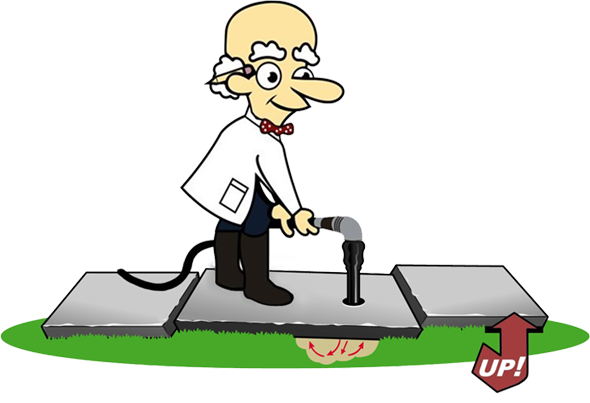IN THIS ARTICLE
Many NJ and PA homeowners with basement water issues have experienced it.
The weatherman is calling for several days of rain. As the drops come down, you hope the rain does not last because the last time this happened, you had puddles of water, or worse, several inches flooding your basement floor.
You have seen all the local basement waterproofing contractor advertisements and decided you will make the call and stop living with a wet basement. But Wait! Do you need to absorb a basement waterproofing cost?
We are a local New Jersey concrete leveling contractor and have helped our customers solve many basement water problems with simple remedies or suggestions without the need for foundation waterproofing or installing a French drain system. Most local basement waterproofing companies near you don’t want you to know that these water problems often begin above ground, not in your basement!
Do I Need a Basement Waterproofing Contractor?
To determine this, you must first determine the cause of your basement water. The two primary sources of water damage are:
Hydrostatic Pressure and Above Grade Surface Water
Let’s Address each one individually
Hydrostatic Pressure:
Hydrostatic pressure is the pressure exerted by a fluid, such as water, due to its weight in a confined space. In the context of a basement, hydrostatic pressure can be a concern, especially if the basement is below the water table or in an area with high groundwater levels. If you have basement flooding with several inches of water, you likely have hydrostatic pressure, which must be remedied with a drainage system.
Here’s how hydrostatic pressure can affect a basement:
- Water Seepage: When the groundwater level rises, it can exert pressure on the walls and floor of the basement. If the basement walls and floor are not properly sealed or waterproofed, water can seep through cracks, joints, or porous concrete, leading to moisture problems, mold growth, and even structural damage over time.
- Structural Damage: Continuous hydrostatic pressure on basement walls can weaken them over time. This pressure can cause cracks, bowing, or even collapse of the walls if not adequately addressed. It can also affect the foundation of the entire structure.
To mitigate hydrostatic pressure in a basement, here are some common solutions
- Waterproofing: Proper waterproofing techniques, such as installing a waterproofing membrane on the exterior walls, can prevent water from entering the basement. Interior waterproofing methods, like installing a perimeter drainage system and a sump pump, can help manage water that does get in.
- French Drains: Installing an Interior French drain or similar drainage system around the perimeter of the basement can help redirect groundwater away from the foundation, relieving hydrostatic pressure. This involves the installation of perforated pipe around the inside footing perimeter.
- Foundation Repair: If you notice cracks or signs of structural damage in your basement walls or foundation, it’s crucial to address these issues promptly to prevent further damage.
- Maintenance: Regularly inspecting your basement for signs of water infiltration and addressing any issues promptly is essential in preventing hydrostatic pressure-related problems.
It’s important to note that dealing with hydrostatic pressure and basement waterproofing can be a complex task. If you’re experiencing issues with hydrostatic pressure in your basement, it’s advisable to consult with a professional waterproofing contractor or structural engineer who can assess the situation and recommend the appropriate solutions for your specific circumstances.
Signs of surface water causing a wet basement:
A wet basement due to surface water issues typically occurs when rainwater, melted snow, or runoff from nearby areas infiltrates the basement. Here are common signs that surface water is causing a wet basement/ Many of these issues can be resolved without the need for a basement waterproofing contractor:
- Water Stains Running Down the Inside Basement Wall from Grade Level: Water stains or discoloration on basement walls or floors are often a clear indicator of water seepage.
- Puddles or Standing Water: After heavy rain or snowmelt, you may notice puddles or standing water in your basement. This is a direct sign that surface water is finding its way inside. Surface drainage issues often cause water to leach inward from the basement wall’s bottom edge.
- Damp or Wet Walls and Floors: Touch the walls and floors of your basement. If they feel damp or wet to the touch, it’s a sign that moisture is getting in from outside.
- Musty Odor: A musty or moldy odor in the basement can indicate the presence of moisture. This odor is often more pronounced after wet weather.
- Efflorescence: White, chalky deposits (efflorescence) on the walls or floor occur when water evaporates and leaves mineral deposits behind. This can indicate that water is infiltrating your basement.
- Cracks and Gaps: Check for cracks in the walls or gaps around windows and doors. Surface water can enter through these openings, especially during heavy rainfall.
- Clogged or Overflowing Gutters and Downspouts: Improperly functioning gutters and downspouts can lead to water overflowing and pooling near the foundation, increasing the risk of basement water infiltration. THIS IS OFTEN THE NUMBER ONE CAUSE OF WET BASEMENT ISSUES AND ONE OF THE EASIEST AND LEAST EXPENSIVE TO CORRECT!
- Settled or Sinking Concrete Patio Slabs and Walkways: Concrete that has dropped and diverted water toward your home foundation contributes to basement moisture problems. These issues can often be resolved with a concrete lifting method called Mudjacking.

- Inadequate Grading: Poorly graded landscaping around your home can cause water to flow toward the foundation rather than away from it. This can increase the likelihood of water entering the basement. This is usually corrected by raising the grade closest to your foundation wall to pitch away from your home. Installing a swale may be necessary if your home is at the bottom of a hill.
- Window Well Issues: If you have window wells in your basement, check to see if they are correctly draining and not accumulating water.
- Bubbling Paint or Wallpaper: Paint or wallpaper in the basement may bubble or peel when moisture gets behind it.
- Visible Mold or Mildew: Excess moisture can lead to mold and mildew growth on walls, floors, or other surfaces in the basement.
How To Solve Basement Water Problems
Addressing surface water issues typically involves improving drainage and taking steps to divert water away from your home’s foundation. Solutions may include:
- Properly functioning gutters and downspouts: Ensure they are clear of debris and direct water away from the foundation.
- Grading: Adjust the slope of your landscape to direct water away from the foundation.
- French drains or exterior drainage systems can help collect and redirect surface water.
- Window well covers: Install covers to prevent water from entering through basement windows.
- Sealing cracks and gaps: Seal any openings where water can enter.
- Waterproofing: Consider basement waterproofing systems and coatings to prevent moisture penetration.
Suppose you’re experiencing persistent wet basement issues due to surface water. In that case, it’s advisable to correct these issues before contacting a basement waterproofing contractor, as their most common method to alleviate water is to install a sump pump and interior drainage pipe systems to get rid of excess water. While sometimes necessary, these systems will recycle surface water and cause sump pumps to run more than necessary, increasing electric bills and premature pump failures.
- Garage Floor Raising and Coating: The Ultimate Guide - June 4, 2024
- Mudjacking Cost: 5 Factors That Affect It - April 10, 2024
- What is The Average Cost of Concrete Leveling in Belle Mead, NJ? - April 4, 2024



